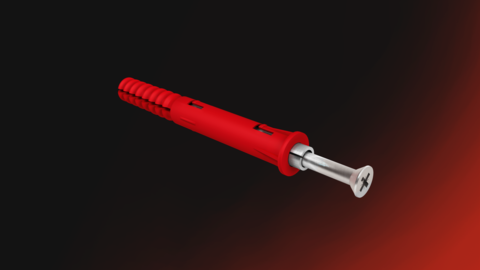Need to Secure Loads to Dot and Dab Plasterboard Walls? Corefix has the answer
If you live in a modern house or have recently had an extension, it is highly likely that the internal wall is built of what is called a drylined construction. Put simply a drylined wall is a solid masonry wall that has been faced with plasterboard, typically supported on blobs of adhesive (hence the term “dot and dab”). These are used to space the plasterboard away from the masonry leaving a void behind.
This generally does not cause any problem until you decide to hang or attach something heavy on it like cupboards, wall mounted televisions, shelves or radiators. In this situation the plasterboard alone will not be capable of bearing the weight, so these need to be anchored to something solid like the masonry behind the plasterboard but this then raises another issue.
A conventional expansion plug and screw or “frame fixing” will typically impart a compressive point load which can deflect or crush the plasterboard into the void. Result: a not very securely fixed television, cupboard or shelf! Not only that but it potentially damages the wall finish and can visually distort the wall. Not at all good if you later want to relocate the item you originally placed there.
Therefore the first thing you must do before trying to attach heavy items to any internal wall is to determine whether the wall you are fixing them to is of a dot and dab, drylined construction. The simplest way to do this is to tap them. Drylined walls will generally sound hollow and in certain places will give off a duller sound, indicating the location of an adhesive blob (dab) or a timber batten. To be certain you may need to drill a small hole though the plasterboard; with drylining you will normally find a void behind the plasterboard and solid masonry at a depth of between about 20-40mm.
What do you do if you have a dot and dab plasterboard wall?
The answer of course is to use something specifically designed for the job, like Corefix. The real secret of Corefix is that it has a steel core which bridges the void between the plasterboard and the masonry. This means that it is not reliant on the strength of the plasterboard because Corefix transfers the load directly to the solid masonry behind via the steel insert.
For such an innovative solution to the problem of dot and dab walls, Corefix is such a simple product to use. You only need tools that every typical household will have, namely; a drill, a hammer and a screwdriver. It is a really quick solution to an age old problem too.
Although Corefix gives you the perfect solution to the dot and dab wall fixing issue, Corefix can also be used on many other types of problem wall that may be found in older properties such as those made from lightweight concrete, bricks or blocks.
Don’t take risks when securing heavy objects to dot and dab plasterboard walls – Corefix it! Use the proven, professional solution.
If you have any questions at all please don’t hesitate to contact us. You can email us or call us for free on 0800 130 3646. Corefix is represented by Metex – Innovation for Construction.




